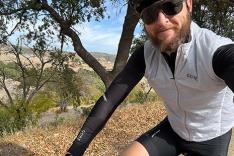3. You Aren't Stepping Up Your Body Work
You know you need some type of strengthening exercise to build muscle. But lift the same 5-pound dumbbells day after day, week after week, and you'll plateau or even backslide, as the effects of age take over.
"Muscles need continual overload to respond and get stronger," says Paul Gordon, PhD, professor and chair of health, human performance and recreation at Baylor University in Waco, Texas and co-author of a recent research review on resistance training and aging in The American Journal of Medicine.
It's what exercise experts call "progression," and it means increasing the difficulty of your workout as you get stronger. If you're brand-new to strength training, start with one day a week of moves that target your major muscle groups—legs, hips, back, abs, chest, shoulders, and arms—using weights that you can lift comfortably 15 to 20 times, Gordon advises. That way, you'll learn the motions safely.
Over time, increase the frequency and intensity of your workout until you're hitting every major muscle group twice per week with weights you can lift only 10 to 12 times. Once that 12th rep feels easy, you'll need to increase the challenge, says Gordon.
Choose heavier dumbbells, body bars, or ankle weights to preserve your results. For extra motivation, try a workout DVD: Fitness trainer Michelle Lovitt can help you get the Ultimate Flat Belly with her expert toning plan (plus, it comes with a free resistance band!).
More from Prevention: 5 Essential Strength-Training Moves Every Woman Needs
4. You're Skimping on Sleep
Pumping iron is just part of the equation: You also need downtime afterward so your body can repair and build new muscle.
Most of this recovery happens during sleep, says Matthew Edlund, MD, director of the Center for Circadian Medicine in Sarasota, Florida, and author of The Power of Rest—especially the deep stages, when your body releases muscle-building human growth hormone.
Guidelines just released by the American Academy of Sleep Medicine advise adults to log at least seven hours per day. But some people need even more. If you conk out the minute your head hits the pillow, you're not getting enough, says Shelby Harris, PsyD, director of the Behavioral Sleep Medicine Program at Montefiore Medical Center in Bronx, N.Y.
Count backward from when you need to get up and book your bedtime like you would any other important appointment, setting aside the hour beforehand for quiet time so you can wind down. Harris suggests a family electronic curfew during that hour—even going so far as to put phones, laptops, and tablets in a box and creating a relaxing routine with books, music, or a warm bath instead.
More from Prevention: 10 Perfect Bedtime Snacks
5. You're Heading Straight to the Bar After Barre
A demanding sweat session can leave you feeling like you've earned that beer or glass of vino. But taking a belt immediately post-workout can interfere with your body's recovery process, meaning you might not reap the rewards of all your hard work.
Booze can disrupt the flow of hormones that prompt your body to produce new muscle proteins, says Matthew Barnes, PhD, of Massey University in New Zealand. Plus, it can interfere with the normal inflammatory process your body uses to repair and strengthen muscle fibers.
You don't have to teetotal to preserve muscle mass, Barnes says. Just wait an hour or so—or toast first with a non-alcoholic beverage and a post-workout snack containing protein and carbohydrate—so that your body has a chance to begin building new muscle.
Once you've rehydrated and refueled, you can celebrate with a glass of the good stuff.
Related Articles:
- 7 Exercises to Tone Your Oblique Muscles
- 6 Butt-Toning Exercises for Women
- 4-Move Arm-Toning Workout
- 7 Exercises to Tone Your Lower Abs
Connect with us on Twitter, Facebook, Instagram or Pinterest for more tips, recipes and ideas to fuel your ACTIVE life.
 Stay in shape in a fitness class or read more fitness articles.
Stay in shape in a fitness class or read more fitness articles.
- 2
- of
- 2
About the Author

Get ACTIVE on the Go


Couch to 5K®
The best way to get new runners off the couch and across the finish line of their first 5K.
Available for iOS | Android







Discuss This Article